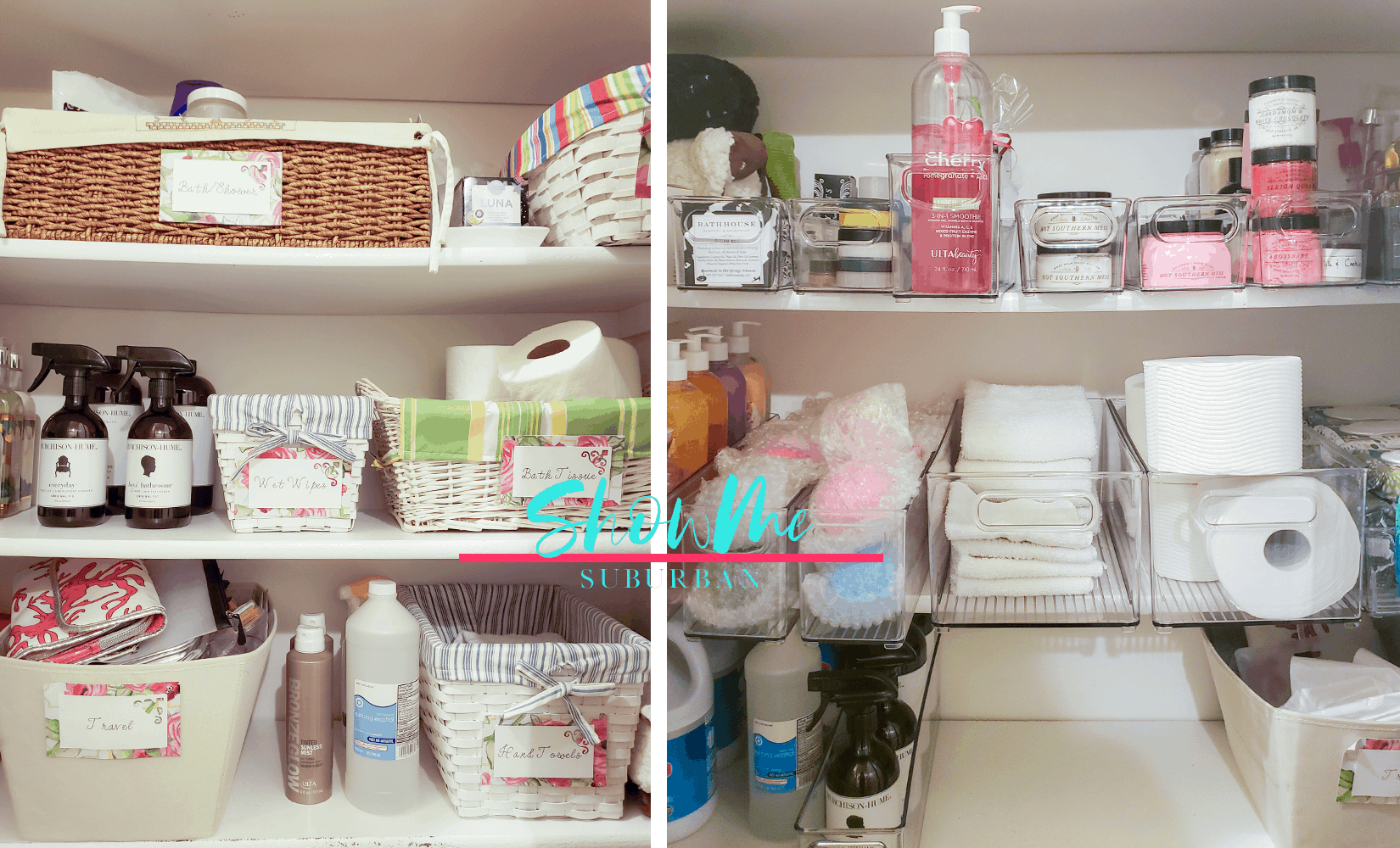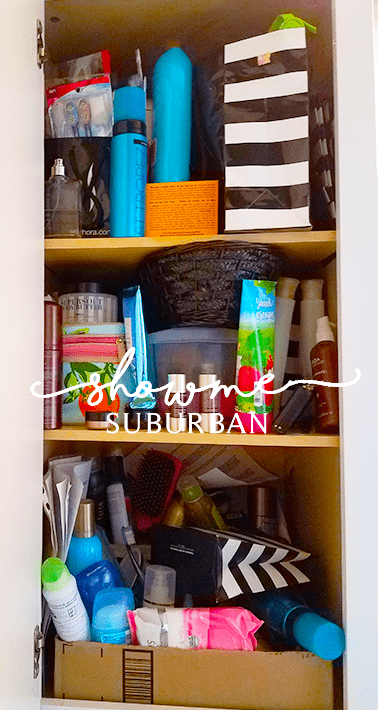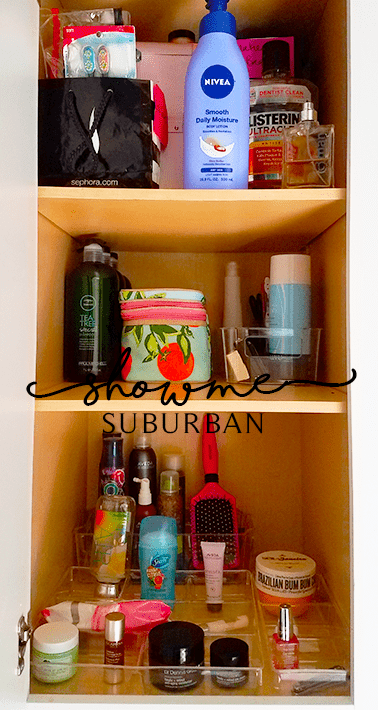This post may contain affiliate links. This means that if you click and make a purchase, I receive a small commission at no additional cost to you. I only recommend products I use and love, or that I would recommend to my mom or best friend. Please see the disclosure statement for additional information.
Choosing the right organizing containers is vital to keeping a home organized. Here are some tips for choosing containers based on your habits and routines, so your spaces stay organized and don’t get cluttered!
Pinterest envy.
You’ve felt it before. Scrolling through your Pinterest feed, you stop momentarily on a pin of a beautiful kitchen, with perfect rows of chic baskets cradling the owner’s perfectly-organized kitchen tools.
You run to Target, drop some change on adorable baskets, get them all set up in your kitchen.
And they’re a wreck a week later.
“I just can’t stay organized,” you tell yourself. But you’re wrong.
By making just one little change, you can keep your home organized consistently.
Organizing Containers: Function Over Form
Truth: When it comes to organizing containers, function is more important than form.
I know, I know. You’re going to think I’m crazy. “But organized spaces are supposed to be pretty!” “But it has to look cute!”
Before you drag me through the streets shouting epithets, let me say that I totally agree. I love a beautiful, clean, Pottery Barn-perfect organized space as much as you do.
And sometimes those beautiful boxes, baskets, and jars are the perfect solution to our organizing needs.
And sometimes they aren’t. But we use them anyway.
Therein lies the problem: We choose containers with form in mind, instead of function. We buy something because it looks nice, not because it will meet our needs.
Let Go of Pinterest Envy
Before we get into how to choose containers, let’s talk about Pinterest envy.
Choosing the right organizing containers is kind of like dressing to flatter your body. Just because something works in someone else’s home, doesn’t mean it’s a good fit for yours. And that’s totally okay! Just like with dressing, your containers should accentuate your strengths and strengthen your weaknesses.
Think of it this way. You see a dress in stock online that’s the wrong size, color, and fit for you, but the dress is pretty. Would you buy that dress? No! You’d save it on Pinterest, and then find something similar in your size and a flattering color. Similarly, when choosing organizing containers, choosing containers that fit your needs is vital. Not just ones that are pretty.
Grace in Organizing
There has been a big push in recent years for women to stop comparing themselves to supermodels and movie stars. That’s a great thing. Giving yourself grace, compassion, and loving your body is healthy and long overdue.
Let’s extend that same grace and compassion to our homes and the way we organize and decorate them. Does that mean that you can’t achieve a beautifully-decorated, well-organized home? No. You definitely can! But you shouldn’t feel bad if your home isn’t there yet, or if your organizing solutions aren’t Pinterest-picture-perfect.
Rock what you’re working with when it comes to organizing and decorating your home, and leave Pinterest envy in the dust. Choose organizing containers because they work for your needs, not just because they have a pretty face.
Okay, speech over. Let’s get to choosing containers!
How to Choose Organizing Containers
Are you great at putting away things that are out of place? Do you forget about things if you can’t readily see them? Do you declutter regularly, or do you tend to get a little lazy at times? How big is your space? How high will the container be? These are all important questions to ask when choosing organizing containers.
Don’t get overwhelmed with my stream of questions. I’m going to break down organizing container selection here and now.
Your habits and routines
The first step in finding organizing containers that will meet your needs is to examine your habits and routines. Understanding yourself and how you operate gives you insight into which containers might work best for your needs, and makes it as easy on yourself as possible to stay organized.
Ask yourself these questions:
Am I great at putting things away that are out of place, or do I tend to leave things sitting out after I use them?
If you tend to put things away more often than not, then containers with lids probably won’t trip you up. Similarly, you may be able to get away with stashing your container in a drawer or cabinet, since opening it to put something away probably won’t be a big deal to you. Cute lidded containers are everywhere on Amazon. I love these:
Full disclosure: I’m just a tiny bit obsessed with SCOUT bins.
If you tend to leave things sitting out, lidded organizing containers probably aren’t for you. At least, not when it comes to items you use frequently.
Why? Because that lid is one more barrier to you putting something away. Similarly, you may have better luck putting things away if the containers are stored out in the open. This removes the barrier of having to open a cabinet door or drawer in order to put something away. The nice part is, if you find a lidded container you love, just take the lid off and put it away somewhere. Easy!
Do I forget about things if I don’t regularly see them?
If “out of sight, out of mind” rings true for you, solid containers might not be your best bet. Because you can’t see the items in a solid container such as a woven basket or fabric bin, you may forget to use them. You also may forget to declutter the space periodically, leaving you with a cute basket or bin full of junk that you no longer use. Clear acrylic organizing containers are a great bet for you. Here are some of my favorites:
By the way – Abby of Just a Girl and Her Blog loves acrylic containers. Check out her awesome post on acrylic containers for more inspiration!
If you don’t forget about things that you can’t readily see, I’m jealous of your brain power. And also, cute opaque containers may work great for you.
Here’s a perfect example of how opaque versus clear containers can radically change a space. I used to use a grab-bag of different baskets in my linen closet. They took up a lot of space, made it difficult to see what was inside some baskets, and didn’t look very streamlined. I switched them out for clear acrylic containers, and they look so much better!

If you love the acrylic bins I used in my linen closet, you can grab them on Amazon:
Do I declutter regularly, or do I tend to be a little lazy?
This is a no-judgment zone. Be honest with yourself. Do you tend to let things pile up a bit? Do you forget to get rid of products that are empty and/or no longer used? If you answered yes to either question, you’ll want to choose containers that:
- Make it easy to see what’s inside, and
- Are small enough to force you to clean them out/declutter regularly
Think low-cut baskets, more acrylic organizers, even wire or plastic baskets that aren’t completely opaque. Basically anything that gives you easy access both physically and visually. Try these on for size:
By the way, if you need help with decluttering, check out my do’s and don’ts for a clutter-free home!
…And if you struggle with decluttering, cleaning may be a challenge too. Check out my post on how to keep your house clean in 30 minutes a day. It’ll help you get a handle on your cleaning routine.
If you’re good about regular decluttering, a wider range of options will work for you. You may be able to get away with lots of opaque bins or cute lidded baskets, because your personality lends itself to using them. Lucky you!
How often will I use these things?
Frequency of use also plays a role in the containers you choose. You’ll want quick, easy access to items used daily. Things that you use less often can be stored in more remote locations, and in less user-friendly containers. These containers are great for items that aren’t used as often:Once you have a good idea of the containers that might work well based on your habits and routines, you need to measure your space.
The size of your space
Before you purchase a single organizing container, you need to measure your space. The worst thing ever (okay, not really) is when you get a container home from the store (Or in the mail), only to find that it doesn’t fit your space. Measure your space by:
- Width (Left to right)
- Depth (Front to back) and
- Height (Bottom to top)
If you’re shopping in-store for organizing containers, take along a tape measure and a list of your space’s measurements. Measure containers you like to see if they’ll work for your space. If they don’t measure up, don’t buy them!
If you’re shopping online, look at the dimensions of containers you like, to ensure they’ll fit in your space. Again, if it won’t fit, skip it.
The height where your container will be
For containers that will sit at eye level, consider something with shorter sides so you can easily see what’s inside. I really like using trays for items that are within a foot or so above or below eye level. I tend to keep items I use frequently within a foot or so of eye level, and trays make it easy to quickly see the items I need. For items that are above or below eye level, the height and type of container also depends on frequency of use. Here are some of my favorite trays for organizing:
Organizing Conainers: A Real-Life Example
A while ago, I opened my bathroom cabinet one day and decided I needed to declutter and reorganize.

Pretty, huh?
This space was overrun with hair and body products. They had commandeered the place, and were partying hard in there. I didn’t even use 80% of the stuff. I had trouble finding the items I use every single day. Kind of embarrassing.
My house is normally very organized, but for some reason, this space had gotten out of control.
The truth is, this bathroom cabinet spiraled into oblivion because I couldn’t see what was inside. I forgot about items, let them pile up, and ended up with a pile of stuff I didn’t use.
Why? Because I had chosen the wrong containers.
Choosing the Right Containers
I started this project by thinking about the space, the items I use, and my habits and routines. As a result, I realized that opaque organizing containers weren’t doing me any favors. Especially that attractive cardboard box! I also realized that if I couldn’t easily see what was inside, I would forget to declutter, and the space would get out of hand again quickly.
After getting rid of the stuff I no longer use, I looked for containers. Since these shelves are right below and right above eye level for me, and I need to easily see everything inside, I settled on some relatively small, acrylic organizing containers. Here’s how it looks now:

I chose a segmented acrylic tray for the skincare items I use daily. Each segment is small enough that clutter can’t accumulate. The sides are low and the entire container is clear, so I can see what’s inside. Similarly, I stored my hair and nail products in low-sided acrylic bins, for easy visual and physical access. I reorganized this space a while ago, and it still looks this good. Why? Because this time around, I chose the right containers.
Is it Pinterest pretty? Not really. Are the containers fun to look at and show off on Facebook? No.
But do they meet my needs and help me stay organized? Yes.
And that’s what matters.
Conclusion
Even the best organizing systems require the right organizing containers . The best organizing containers for you and your space are determined by a number of factors. These include:
- Your habits and routines
- The size of your space
- The height at which the container will sit
By far, the biggest issue to consider is your own behavior. Your habits, routines, and lifestyle have a significant influence on the organizing containers that are best for you. Be honest with yourself about how often you declutter, put things away, or forget things are even there. Give yourself grace if your organized spaces don’t look Pinterest perfect. After all, Pinterest won’t be there when the wrong organizing containers fail you. But you’ll be glad when the right containers help you stay organized.
P.S. – Have small spaces in your house that always end up cluttered? Check out my post on how to keep small spaces organized!

I am so glad you point out the fact that function should take priority over form when choosing storage containers! It’s seriously so easy to fall victim to buying a certain style of bin or basket because of its cute design only to realize when you get home that it won’t fit all the items we need to store. I definitely agree that the most important thing is to focus on choosing an organizational container that will suit your needs.